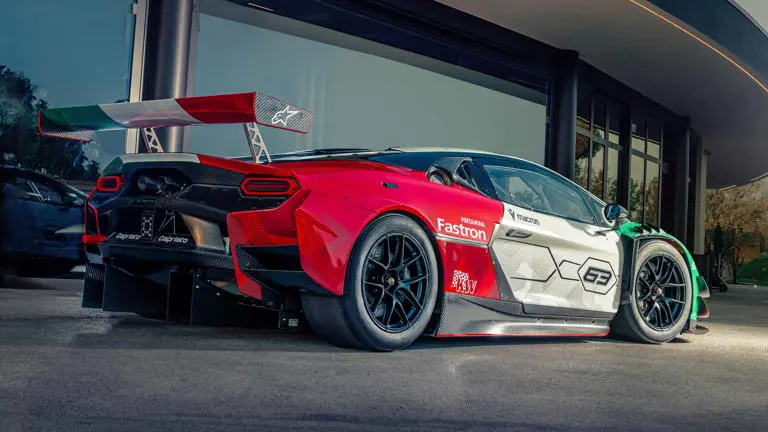In a garage full of dreams, there’s a sudden hiss of turbo pressure and a deep growl from a V8 engine. The Lamborghini Temerario GT3 isn’t pretending to be a star of the track – it already is. What fascinates me most is the way this car was built from scratch in Sant’Agata Bolognese, Italy. It wasn’t an afterthought or a modified street version. This is a purebred race car with the soul of its road-going sibling, but with one goal only – to be the fastest.
From Sketch to Starting Line: Zero Compromise
When Lamborghini kicked off the Temerario project, they knew exactly what they wanted. This wouldn’t be just another showroom piece. Every bolt, every curve of the body was designed with motorsport in mind. The GT3 version wasn’t just “tacked on” later – it was meant to exist from day one.

The result? The Lamborghini Temerario GT3, Lamborghini’s first race car fully designed, built, and engineered in-house, represents a seamless marriage between design and competition. Where the road car features electric motors and hybrid elements, the GT3 version strips everything down to focus on raw racing power, a new transmission, and endless modular options for mechanics and drivers to fully exploit.
Under the Hood: Fire and Fury
Forget the quiet hum of hybrid modes. The Temerario GT3 goes all-in on classic muscle: a reworked 4-liter V8 twin-turbo engine. Yes, it shares its core with the road model, but it’s been entirely reshaped to meet strict GT3 regulations – and still keep its Lamborghini character. With 550 horsepower (limited by Balance of Performance rules) instead of the original 800 hp, this thing still flies thanks to low weight and aggressive aero.
What caught my attention most is the flat-plane crankshaft – a 180-degree layout typically found in racing engines – giving the engine not only smoother firing but also that signature high-pitched roar that raises goosebumps. Add in titanium connecting rods and customized turbos, and you get an engine that feels alive and ready to pounce.
Lightweight Chassis, Built for the Pitlane
The Lamborghini Temerario GT3 chassis begins with an aluminum spaceframe borrowed from the road car but stripped and re-engineered for race demands. Squadra Corse (Lamborghini’s motorsport division) introduced a quick-removal system for the front and rear subframes, making pit work faster and more efficient. Gone are all the hybrid support structures. In their place: a welded FIA-approved roll cage and optimized service access.
The rear subframe, in particular, is a clever piece of design, allowing technicians to remove and reattach it quickly, which is a massive win during long endurance races. The front subframe no longer houses electric motors, meaning it’s lighter and more purposeful.
Carbon Skin and Intelligent Aerodynamics
Temerario GT3 is wrapped in carbon composite body panels for the first time in Lamborghini GT3 history, slicing down its base weight. The Squadra Corse aero team worked closely with Lamborghini Centro Stile to preserve the road car’s distinctive silhouette while turning every vent and panel into a weapon of downforce and cooling efficiency.

Quick-release design is everywhere – single-piece front and rear ends, removable engine covers, even headlights with quick connectors. The floor is segmented into four parts, including a massive rear diffuser and a removable center section that can be swapped out while the car sits on its air jacks.
The updated fuel tank has a higher flow rate for faster pit stops, and the new sensor tech inside gives teams more accurate readings. Cooling was another big focus: airflow to the radiators is improved, the layout of the front radiator is redesigned, and without the hybrid components, the turbos now demand better heat management, which Lamborghini tackled with precision.
Engineered to Race, Tuned to Thrill
The powertrain is a work of art. While GT3 rules forbid hybrid systems, Lamborghini didn’t just rip them out – they reimagined the engine’s delivery. Paired with a custom six-speed transverse gearbox and a new airbox suited to compact turbos, the engine has been completely remapped for performance over a broader rev range.
And it runs on Pertamina Fastron racing motor oil, developed in tandem with the car. Even the exhaust system is bespoke, designed by Capristo to match the GT3’s brutal performance and sound.
Wider, Lower, Meaner: Suspension & Wheels
The new GT3 rides on a longer wheelbase and a wider track both front and rear, dialing up the car’s cornering grip. Lamborghini also introduced six-way adjustable KW dampers, the same tech used in their SC63 LMDh car. These allow teams to rapidly fine-tune suspension settings during practice sessions.

Gone are the carbon inserts in the chassis; instead, the suspension now bolts to mounting plates, improving serviceability. It all rides on 18-inch wheels from Ronal AG, wrapped in tires compatible with every major GT3 supplier. Lamborghini even developed a custom hydraulic steering rack to extract the most out of this geometry. Every inch was built for one thing: domination.
Inside the Cockpit: Built by Drivers, for Drivers
Lamborghini’s factory drivers Marco Mapelli and Andrea Caldarelli played a key role in refining the cockpit. Thanks to their feedback, the driving position, controls, and data access were all tailored for top-tier racing.
New electronics bring a fresh software suite developed in-house. The updated switchgear has cleaner graphics, and the data logger is now more comprehensive. The steering wheel? Custom-built to Lamborghini’s spec, designed with input from both factory and customer racers.
On the Grid: The New Era Begins
The Temerario GT3 will hit the track during the 2026 season, making its debut at the iconic 12 Hours of Sebring. Designed to be compatible with all GT3 tire suppliers and regulations, it’s Lamborghini’s answer to customer teams demanding more precision, more durability, and more thrills.
And don’t worry, if your team still runs the Huracán GT3, Lamborghini will keep full tech support throughout the transition. Because when they commit to racing, they mean it.
Global Access to GT3: Why a VPN is a Game Changer
If you’ve ever tried watching international GT3 series on your usual sports platform while abroad, you know how frustrating those ‘content not available in your region’ messages can be. A VPN solves that in seconds. It’s like having a pit pass to every race, wherever you are.
I always keep a VPN installed when I travel – not just for streaming race weekends live, but also for securing my data while on public Wi-Fi at airports, hotels, or racetracks. It’s one of those must-have tools that protects your online activity and unlocks all the racing action, no matter where you are.
Here are my top 5 VPNs I’ve tested and trust
- NordVPN – Lightning-fast speeds and the best for unblocking sports streams globally.
- Surfshark – Great value, unlimited devices, and super easy to use.
- ExpressVPN – Ultra-reliable, top-tier security, and works flawlessly even in strict regions.
- CyberGhost – Pre-configured servers for streaming, intuitive UI.
- Private Internet Access (PIA) – Excellent for advanced users with tons of customization.
| Best VPN for streaming | Offer + Discount | URL |
|---|---|---|
| NordVPN | 77% off + 3 months free | Try NordVPN |
| ExpressVPN | 61% off + 6 months free | Try ExpressVPN |
| SurfShark | 87% off + 2 months free | Try SurfShark |
| CyberGhost | 83% off + 2 months free | Try CyberGhost |
| PIA VPN | 82% off + 2 months free | Try PIA VPN |
Whether you’re following the GT3 circuit from a café in Italy or watching Sebring from your hotel in Tokyo, a VPN gives you freedom, speed, and protection. That’s a podium finish in my book.











